#Laird Borrelli-Persson
Explore tagged Tumblr posts
Text

"Fortnight" music video | April 19, 2024
Elena Velez Fall 2024 skirt
In authentic Victorian fashion, this black ensemble Taylor wore was actually separates and not a dress. Her waxed denim jacket as previously posted was by Unttld and this ruffled skirt by Elena Valez from her Fall 2024 collection which only debuted this past February. Elena told Laird Borrelli-Persson for Vogue that her “purest objective as a brand is to really bring a lost Midwestern woman back to the American cultural narrative.” Her desires in this collection were to bring a “more multi-dimensional representation of womanhood, good and bad; one that accepts the difficult, complicated, ugly truth of being a woman as part of the beauty that makes us whole and complete and 360. It’s a character journey that sometimes goes through an antagonist journey, but ultimately resolves itself with meaning and goodwill.” I frankly can’t think of a better ethos to match an album that centers much of its narrative on Taylor exposing wounds many of which she describes as “self-inflicted.”
It’s my suspicion that TTPD is not an album that will be, nor was designed with the intention of, understood or liked by the masses. To my ears (and still overwhelmed brain feeling like I’ve absorbed an encyclopedia of words across these 31 songs) this is an album for ‘Swiftie scholars’ who have the time, space, and devotion to wade through the heaviness of an album this dense and complicated. And that’s okay! When Taylor described this album as one that she needed to make, now that we have it I interpret her meaning as her willfully confronting and hurdling over the elephant in the studio with her. Addressing the “how did it end?” questions that will plague her as soon as possible and structuring it in an album messy, complicated, and strewn with all her most vicious thoughts about the last year of her life in order to get out from under the weighted blanket of those expectations, clearing a path for her next LP to be constructed in clearer air.
Worn with: Unttld jacket
314 notes
·
View notes
Text
Sustainable fashion brands:
Ka-Sha, India
"Change by design" is a type of slogan for Karishma Shahani-Khan and her Maharashtra, India-based label, Ka-Sha. Ka-Sha's tale is as much about the craftsmen she works with around the country as it is about the natural, hand-dyed materials and zero-waste design approaches. "We use clothing to celebrate handcraft and artisanal techniques, both new and old," adds Shahani-Khan. Heart to Haat, the label's capsule project, is made completely of abandoned fabrics and clothing intended for garbage, and is inspired by the indigenous idea of recycling, repurposing, and reclaiming." Emily Farrah

Mozh Mozh, Peru
Mozhdeh Matin founded her label in 2015 to "work with local artisans and preserve their techniques," she says. She was inspired by the notion of a circular economy, and her vibrant pieces, dresses, and accessories - fashioned from alpaca, cotton, and wool yarns also indigenous to Peru - have set that wheel in motion. "All artists take inspiration from their surroundings," she said, "and the climate crisis is pushing a lot of us to create inventive ways to become more sustainable." - Marius Marley

Conner Ives, Britain
At least 75% of the materials used in this Central Saint Martins graduate's creations are old, deadstock, or sustainable. "It's always about finding new materials to use and new processes to develop," Ives said. "It's a constant and hungry evolution." The designer, who is from Bedford, New York, claims that residing in England has affected the way he acquires and uses vintage materials. "When I first got to London, I spent most of my time with friends going to charity shops," said Ives. "I so much enjoy the hunt." Christian Allaire's
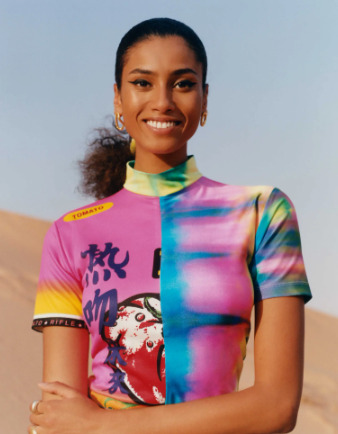
Morphine, Italy
Morphine is a unique brand-turned-retailer founded in Reggio Emilia, Italy, that sells old designer things - think '90s Comme des Garçons and early-Noughties McQueen - as well as its own repurposed pieces through its Compendium 01: Pazzesca line. "Our process consists in reawakening and reviving products that this industry has produced and forgotten," Morphine project manager Sasha Payton explains. "We produce one-of-a-kind items by customising and reassembling clothing, fabrics and yarns from deadstock and leftovers from across the Italian supply chain." - CA
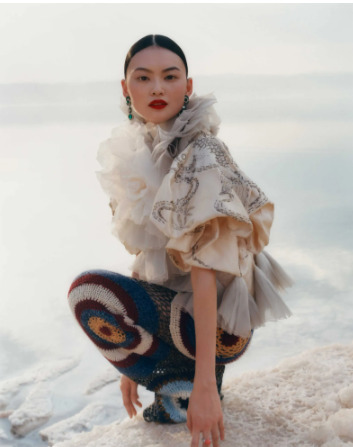
Vitelli, Italy
Vitelli's manufacturing is entirely comprised of waste from the knitwear industry, much of which would otherwise end up in a landfill. This waste is then utilised to make the label's patented felted material, nicknamed Doomboh, which is then converted into clever, tactile items. "The atelier inside my studio is called Organic Knitting Theatre," explains Vitelli's creator and creative director, Mauro Simionato. "Every day, we gather and create." What is his major source of inspiration? The "music-driven, post-hippie" Italian counterculture movement that sprung up in the late '70s and early '80s around the Cosmic club on the Adriatic Riviera. Vitelli has interpreted this scenario "as a model of how to participate in - and possibly inspire - the current global cosmic scene." - Lieutenant Laird Borrelli-Persson

Juan de La Paz, Bolivia
Juan de La Paz was formed in 2009 by designers Juan Carlos Pereira and Andrés Jordan, who develop their vivid designs in collaboration with craftspeople in Bolivia and Peru. "We learn from the ancestral knowledge of these communities to take care of Mother Earth when making fashion," Pereira goes on to explain. The clothing, the majority of which include the label's distinctive fringing, are created from recycled materials (the range is also made-to-order and zero waste). According to both designers, being Bolivian makes sustainability necessary and clear. "Contemporary Latin American design upcycles, looks for alternative materials, collaborates with indigenous communities and values artisan craftsmanship," Jordan said. - California
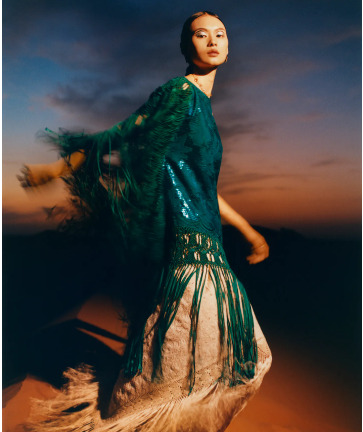
Rave Review, Sweden
The path to a responsible future, according to Rave Review's Josephine Bergqvist and Livia Schück, is through the past. The team has always worked with existing materials, which they piece together to create unique sculptures. "These fabrics are so nice to work with - and in a way it feels more 'new' to work this way rather than to redesign existing fashions," Bergqvist said. The designers frequently claim that their work is nostalgic by default since their materials had former lives - but it's how these Swedes filter their work via their own childhood recollections and present interests that has garnered wonderful accolades. - LB-P
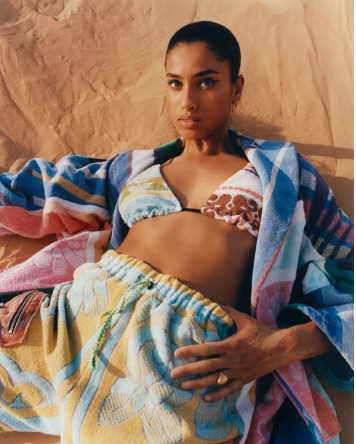
Referencing:
Vogue. (2022). 15 Global Brands Bringing Fashion And Sustainability Together. [Online]. British Vogue. Last Updated: 25 January 2022. Available at: https://www.vogue.co.uk/fashion/article/global-sustainable-fashion-brands [Accessed 6 November 2023].
2 notes
·
View notes
Text




This New Line of Bridal Hats Lets a Woman “Be the Bride and the Cake”
BY LAIRD BORRELLI-PERSSON
4 notes
·
View notes
Text
Harvard referencing
Laird Borrelli-Persson. (2024). The Key Spring/Summer 2025 Trends To Know Now. [Online]. British vogue. Last Updated: 15 October 2024. Available at: https://www.vogue.co.uk/article/spring-summer-2025-fashion-trends [Accessed 10 December 2024].
( this is the Harvard referencing to the website link of vogue i pick my ss25 key trends from)
Maxine Eggenberger. (2024). The Spring/Summer 2025 Fashion Trends That Actually Matter Now. [Online]. WHO WHAT WEAR. Last Updated: 3 December 2024. Available at: https://www.whowhatwear.com/fashion/trends/spring-summer-2025-fashion-trends [Accessed 12 December 2024].
This is the another Harvard referencing to the another website I've looked at.
0 notes
Text
The Autumn Analysis & Ridley London
From the catwalks to the latest collections, the mood has shifted. Here are the six most wearable and lasting trends to invest in for Autumn and Winter 2024
Recently waking to crisper mornings and yellowing leaves I’d forgotten how much I love Autumn. It’s as if we have a biological and symbiotic relationship with the onset of cooler days and shorter nights. It’s this moment that has me instantly emotionally ready for the deeper, richer colour palettes that reflect the change in nature and welcome the onset of the new cultural calendar: back to school, logs on the fireplace, and of course a pivotal point in the annual fashion calendar for designers and fans alike.
This Autumn’s collections on the catwalks and the high streets are inspiring but constrained, reflecting a much needed step change away from endless novelty towards a slower and more measured style of fashion that we have long championed here at Ridley. As Laird Borrelli Persson for Vogue aptly summarised the Autumn collections as, ‘Real as opposed to fantastical.’ Fashion after all is a collective interpretation of the Zeitgeist, and designers across the board have responded to continued conflict and uncertainty by offering a much needed sense of balance and assurance with a visible shift towards more elegant, sophisticated and timeless dressing. As fashion bible Who What Wear aptly points out "Well-cut skirt suits, tailored coats, smart handbags, sharp shoes and chic shift dresses come together to create a wardrobe that's made for women, not little girls.”
It’s true that fashion can feel frivolous in comparison to the daily headlines, raging wars, budgets and some of the most crucial governmental elections of our time. But it also has a crucial social role to play. At its best fashion can nourish us, an art form that provides gentle relief away from a turbulent world. And as science has shown, our sartorial choices directly affect our psychology and behaviour, while helping to cultivate and project our individual identities. The right clothes can literally put a spring into your step, helping you face your daily challenges with confidence and a renewed sense of energy and purpose. In tough times, maybe a new dress, skirt or accessory really does hold some of the answers. I just hope this season's garments truly live up to the 'investment piece’ label many are touting. While a shift towards 'slow fashion’ is welcome, it’s vital it's bothauthentic and lasting. As consumers, we can take that little extra bit of care to examine the labels, ask the right questions, and in short demand that our garments are made ethically and made to last. Otherwise this will just be another shallow style statement and a major opportunity missed. With this in mind, here’s are pick of this Autumn’s most wearable and important trends, and as elite Hollywood stylist Micaela Erlanger puts it: “The fashion cycle moves fast, so you don't need to participate in every trend that comes up — just the ones that speak to you."
1. Return to elegance
Catwalks this season have seen a marked return to the simple elegance of a bygone era with refined feminine silhouettes reminiscent of the late 50’s and early 60’s. Colours are predominantly muted punctuated by rich jewel tones in silk satins. Key styles include duchess satin shift dresses, tweed twin sets in Autumn muted tones, pencil skirts, swing coats and tailored woollens that appear to beg for a pair of shades, pearls or a fur collar. This vintage aesthetic is best epitomised by Prada’s new collection styled with vintage pearl necklaces and broaches. Mark Jacobs adapted the look with colour blocking and exaggerated silhouettes. At Ridley we have long championed the merits of classically feminine cuts and exquisite tailoring. This season’s collection features a number of elegant new dress styles inspired by vintage silhouettes that are both easy, flattering and available in a spectrum of jewel tone silks and unique floral prints. We are also introducing a new collection of vintage style pencil skirts that pair beautifully with our silk tops and blouses. For the ultimate in on-trend elegance, style your dress or separates with one of our chic tailored jackets or a statement full length opera coat. Both are available in tweeds and a spectrum of rich seasonal velvets.
2. Rich seasonal colours and shimmering satins
Elegance doesn’t have to mean boring, as Who What Wear points out "It’s also about dressing with authentically individual style that reflects our true selves”, and colour and print appear to be the prime choice of self expression this season. While styles tend towards the understated and classical, designers are unanimously using colour as a counterpoint to add modernity and energy across their collections. Whether it’s a sweater, blouse, draped scarf, bag or entire dress, embrace this season's colour palette of natural autumnal tones including vivid reds, earthy greens rich burgundies, sky blues and versatile navy. Nowhere has this colour trend more apparent than in the spectrum of shimmering satin creations that have adorned so many of this season’s catwalks. Whether it’s an on-trend pair of silk day pyjamas, a versatile blouse, fluid jumpsuit or a sumptuous dress, satin introduces a touch of luxury and timeless glamour to wardrobes. But wear it wisely as certain styles combined with satin's reflective nature can highlight unsightly areas creating a less than flattering silhouette. At Ridley we help customers find the style and colour that’s right for them, and all of our dresses, tops and jumpsuits can be ingeniously customised and tailored for the most flattering fit.
3. Animal instincts
This Autumn’s catwalk shows featured a panoply of sophisticated textiles dyed to mimic the exotic creatures of the African continent. Fashion houses showcased dresses, coats and accessories in versions of leopard, tiger and zebra prints, including nostalgic references to 1950’s leopard from Dior, as well as exaggerated zebra prints from Ellie Saab, all in the deeper tones best suited to the season. Stella McCartney excited us with animal prints in muted natural colours. The pieces looked more like an animal hide come to life. These looks together punctuated the theme of animal prints as highly adaptable with hyperbolic versions very much in the forefront. In harmony with this sartorial favourite, Ridley has introduced a new collection of animal style prints including Zenab tiger fabric in khaki and inky green shown here on one of our iconic shirt dresses. The classic cut allows the design of the fabric to feature without hindrance and the ease of wear suits every body shape. Finally, the beauty of animal prints is they transition easily from day to evening extending the possibilities with a change in accessories.
4. Late bloomers
Florals aren’t just for summer. Floral dresses and separates made a much-welcomed return for the Autumn 2024 collections. Catwalks have been filled with vivid multi-toned floral looks, from the more discrete to bold floral blooms. Loewe featured dresses in bright florals on white backgrounds paired with biker boots for contrast. Yanina Couture opted for dresses fashioned as glorious gardens that looked photographic with graduating flowers to the hemline. Meanwhile, Ulla Johnson flirted with florals in unusual mesh treatments and Marchesa showcased two-toned florals in a mini dress. Finally, Erdem introduced floral dresses with abstract geometric overlays for a more whimsical aesthetic. Ridley is synonymous with our use of floral prints, and this Autumn's collection features florals in deeper, earthy hues which contrast beautifully with our elegantly feminine silhouettes. Our new Elena dress in mid-tone florals for Autumn is an amazingly versatile long-sleeve dress that will carry you through all sorts of occasions and into winter simply by moving from heels to boots and adding a velvet jacket. Our Carla dress in the emerald and citrine Artists Bouquet silk twill print is equally adaptable and is already proving a popular choice with winter wedding guests.
5. County chic
According to Vogue ‘country house weekends are trending’, and this season’s must have heritage tweeds, herringbones, argyles and tartans perfectly capture the practical and nostalgic spirit of traditional rural style with a mixture of classical avante-garde versions. Loewe’s Autumn collection favours enlarged tartan plaids, while Stella McCarthy has opted for more traditional tweeds adding a modern edge with her contemporary cut. Whether you opt for classical or contemporary style, good quality tweed is both comfortable and hardwearing, making any garment an instant investment piece. A point much favoured by Royalty and aristocracy. Our tweed here at Ridley is woven by Linton Tweeds of Carlisle who have supplied some of the most celebrated fashion houses and designers for over 100 years, including the legendary Coco Chanel who rumour has it had a longstanding liaison with the founder. We have worked with Linton Tweeds for over 30 years and the quality of their yarn is second to none, lending our tweed garments a unique combination of fluidity, softness and durability. As shown this season in our tailored tweed jackets, over coats, skirts and trousers.
6. Boho sleek
Customers yearn for pieces that will stand the test of time, and increasingly these days act as an investment for future fashion resale. Or styles that can be easily repurposed with a few key pieces to create a fresh, updated look. Timelessness needn’t be limited to a sombre aesthetic of quiet luxury. A glance at this season’s catwalks proves that the bohemian, laid back, creative aesthetic of the 70’s seems just as timeless and relevant as ever. And as Who What Wear points out there has been a recent spike in searches for boho fashion. Successively championed by the likes of Chanel and Fendi with chiffon blouses, tiered dresses and aviator glasses, the look is back with vengeance this season lead by Chloé. If there was ever proof of the timelessness of this trend, according to Google, searches for Chloé increased 35% in the 48 hours following the brand’s A/W 2024 show in Paris this March. Our collections here at Ridley have always featured more than a dash of sleek bohemian style. Not only is it super glamorous, romantic and sexy, but it lends itself to beautiful silks, overblown floral prints. Most of all the style is incredibly comfortable and flattering to wear, balloon sleeves, a-line style maxi skirts and cuts that skim the hips and draw in at the waist all help to create an enhanced, flattering silhouette for almost every body shape. If you’re looking to add a touch of sleek boho glamour to your wardrobe this autumn, our new Ella dress is perfect and can be customised for your perfect fit in a spectrum of sumptuous silk shades and luxurious prints.
Ridley London's new collection of dresses, skirts, tops, jackets and knitwear for is available to purchase online and in Ridley's Barnes store. Celebrate your individuality this season with a unique piece that's customised to flatter in your choice of any of our stunning new printed florals or solid silks or luxurious velvets. Or call us to arrange a virtual fitting:
Ridley London, 82 Church Road, Barnes, London SW13 0DQ T: 01730 823097
0 notes
Text


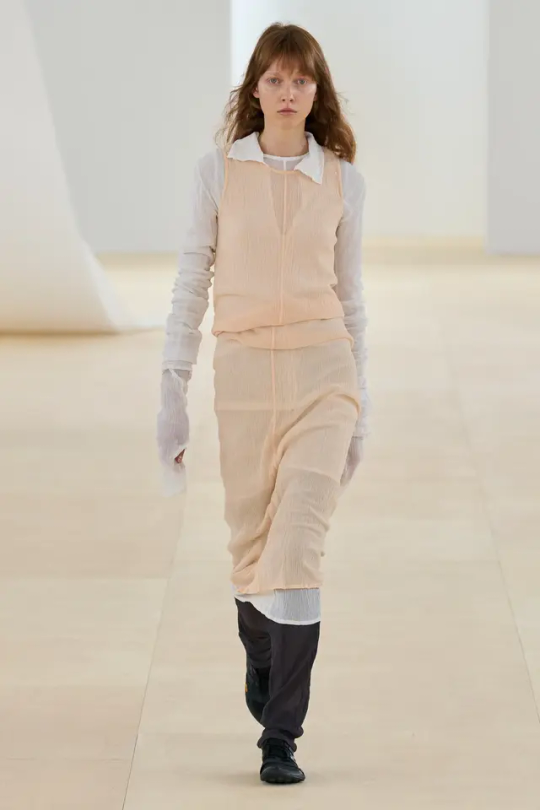



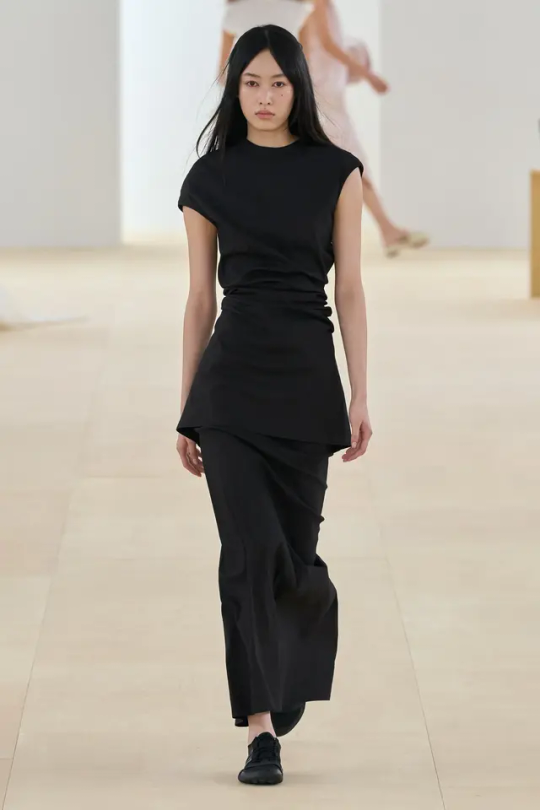





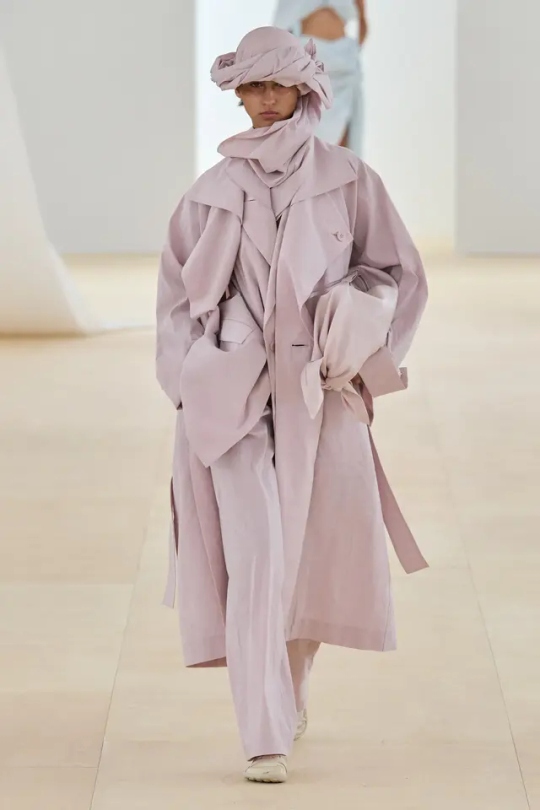


youtube
Issey Miyake SS24
Luke Leitch's review for Vogue:
Props (and thanks) to Vogue colleague José Criales-Unzueta, who after this show noted and posted to his Instagram a runway redux of Issey Miyake’s Spring 1998 show written by Laird Borrelli-Persson. As you can see by comparing the galleries, Miyake’s “tube veils” from that year were riffed on—and extended into real veils—by Satoshi Kondo at this morning’s show in Paris. That was one of Miyake’s final shows as creative director: following his death last summer, the Miyake family continues to hold the candle for their founder.
Kondo’s dynamic experiments with high twist yarns played against the bodies beneath them in a manner comparable to the fluttering of a flag in the breeze, an image that the designer cited as a starting point. At points of movement, hips and shoulders, the fabric found its own volume and settled into a natural, unenforced drape created by the human weather within it.
A series of prints showing grainy shafts of light were developed from exposed film, another 1990s throwback. Then we saw painstakingly fashioned dresses cut from single tubes of washi paper and polyester mix that were manipulated to fold back and forth around subtle cut-out sections: these were both highly technical and deeply romantic. The models sometimes wore Vibram-soled barefoot running shoes by New Balance in Kondo directed colorways.
Some large-silhouette jackets and coats appeared so considerable thanks to the way in which the front and back facing pieces of material were placed flat against each other around the edge of the front-facing physical facade: this was a little reminiscent of last season’s collection, and retained an impressive combination of substance and lightness. The soundsystem played a bassline so heavy and loud that the pieces of washi paper hanging across the runway turned and trembled as the models walked breezily by.
0 notes
Text
artistic vision statement and Social engagement
In week 10, I learned how to craft a statement of artistic vision. During the activities this week, we discussed our personal strengths and visions in five years and even further.
My design strength is mainly illustration, so I would like to be an illustrator who does advertisement and book cover designs in the near future if possible. I have done some personal and commercial commissions before, and I plan to do more as part of my further practice and to add to my personal portfolio. At the same time, I would actively participate in internship programs, working for graphic design agencies based in Singapore like Design Start and Graphic Masters, to gain more experience.
One of the best designers I admire is J.C. Leyendecker, the pioneering American illustrator and graphic designer. He is best known for his illustration posters and magazine cover designs. More than 600 original paintings, photographs, advertisements, and magazine covers, including all 322 for the Saturday Evening Post, show the brilliance and importance of this powerful designer. He has created impactful advertising illustrations, and this set of Arrow Collars advertisement posters is my favourite, which I consider has greate social engagement at that time.

In this refined poster, the well-known Arrow Collar Man was right at the centre. The black background within the elliptical frame enhances the contrast of the portrait and makes it the impressive focus of this work. Beautiful and symmetricla patterns and words “Arrow The Aristocrat Of Collars”on the frame allows people to associate their product with elegance and nobility.
With the help of Leyendecker's illustrations, Arrow went to the top of the industry. Their impressive rise drew much attention and changed everyone's perception of marketing. J.C. Leyendecker’s design for Arrow appeared everywhere in the 1920s, often with beautiful frames around his images of collar designs. Leyendecker's work with Arrow Collars marked a shift in advertising strategy. The emphasis on creating distinct brand images and icons, makes great impact on design in the future.
The poster not only promoted products but also contributed to shaping American cultural ideals and trends. The Arrow Collar Man, Charles Beach, set the standard for elegance, for what a sophisticated gentleman should not just look like but be. The Arrow Collar Man represented the American Spirit. And by such association of their product with a certain lifestyle, consumerism was well promoted. This is one of the reasons why it was so successful.
I prefer using illustrations in design because they are extremely alluring and easy for readers to empathise with, thereby arousing potential customers’ interest in the product. What I wish to do in the future is to create impressive brand images with my illustrations and create advertisements and products that can affect certain customer’s pursuit of lifestyle and aesthetics, just like J.C. Leyendecker.
(470 words)
Fig. 1. Arrow Collar Man. Borrelli-Persson, Laird. “The Secret Life of the Arrow Collar Man.” Vogue, 12 June 2017, www.vogue.com/article/pride-2017-leyendecker-arrow-collar-man-sex-symbol.
0 notes
Text
Referencing
Laird Borrelli- Persson (2021) The Stars and Strips as seen by Fashion Designers. Available at: https://www.vogue.com/article/how-the-american-flag-has-been-used-in-fashion [Accessed September 8 2021].
No name (2015) 10 Weavers to get you weaving. Available at: https://make.works/blog/inspiring-weavers [Accessed June 25 2015]
Hannah Banks Walker (2023) These designers believe that traditional craftmanship is the future of fashion. Available at: https://www.harpersbazaar.com/uk/fashion/a44670972/fashion-designers-traditional-craftsmanship/ [Accessed 4 August 2023]
No name (2021) Studio, street and smile. Available at: https://www.vam.ac.uk/articles/james-barnor
No name (2023) https://www.vam.ac.uk/articles/althea-mcnish-an-introduction
No name https://largebeast.tumblr.com/post/76144046608/by-tyler-spangler
No namehttps://caralondonuca.wordpress.com/2019/01/05/artist-research/
0 notes
Text

Olivier Theyskens, A/W 1998-99.
“Though the collection was dubbed “gothic” by Vogue, the designer says that at the time he loved to look at Florentine studies of anatomy, as well as the 17th and 18th centuries and also the end of the 19th century, with its beads and lace. ‘I was just putting together all these passions. I was also discovering how to do voluminous garments, it was the first collection where I put trains on the dresses. When I look back, some of the charm of this collection is that I can tell how much I’m trying different types of things as a discoverer or explorer, I was really doing things mostly for the first time.’” - Laird Borrelli-Persson, October 2017.
26 notes
·
View notes
Quote
“I’ve always enjoyed dressing up,” admitted Harvey, who has penned songs with titles like “Dress” and “That Was My Veil.” Photographer Maria Mochnacz, who has worked closely on imagery with the singer, has described Harvey’s style in the early ’00s as “short and skimpy and brightly colored and a bit punk rock.” In light of Vetements’s elevation of streetwear, Harvey’s upcycled band T-shirt ensembles seem prescient, as does her early adoption of Victoriana, fashion’s current preoccupation. Mochnacz’s twin, Annie, is responsible for the leg-of-mutton looks, made of materials sourced from vintage shops and made along the lines of 18th-century dress patterns. In 2011, Harvey accepted her Mercury Prize in a corseted white dress and feathered headdress designed by Ann Demeulemeester, famous for her “poet warrior” silhouette and her longtime muse, Patti Smith, to whom Harvey has often been compared. Harvey’s own muse-dom extends beyond her wardrobe; on some level the singer operates in a way that mimics the fashion system itself. Harvey changes tack with each album, much as designers do season to season. “The starting point,” Harvey told Pitchfork, “is always that I don’t want to repeat myself. Or I try my best not to, with varying degrees of success.” The singer has also grappled with the idea of access, a subject that consumed the insider-y fashion industry this season. Harvey turned the making of her new album, The Hope Six Demolition Project, dropping April 15, into performance art via open-to-the-public “Recording in Process” viewing sessions under Somerset House organized with Artangel. Like Let England Shake, which has been characterized as an anti-war album, Hope Six is overtly political. The title references the controversial American HOPE VI initiative, which aims to rehabilitate urban projects but, some argue, destroys communities. The soundtrack that accompanied Miuccia Prada’s assemblage-style fashions down the runway last month was heavy on Harvey. In addition to playing “To Bring You My Love,” DJ Frédéric Sanchez also used a spoken-word version of Harvey’s poem “The Guest Room” (originally published in The New Yorker). Both lyrics and verse speak of dislocation and journeys, topics addressed by Prada, who brought up “vagabonds” backstage, and by Harvey in her new single “The Wheel.” What she wears (a black suit and a gauzy white top over a black tank) is less important than her stance, which is politicized, in keeping with the current climate. “I’ve always been very affected by what’s going on in the world, politically, socially, in every way,” said Harvey, and it’s because she stands for something that Harvey is a muse that matters.
Laird Borrelli-Persson, Why PJ Harvey Is a Muse for Our Times
6 notes
·
View notes
Text
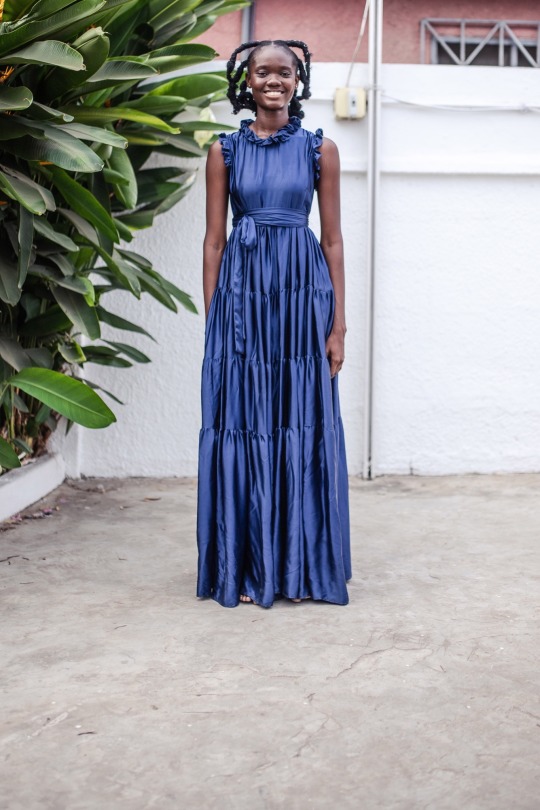
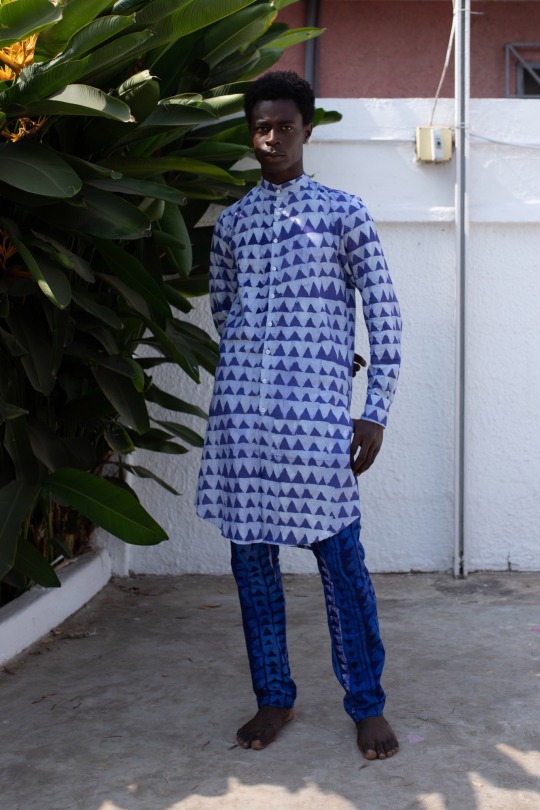
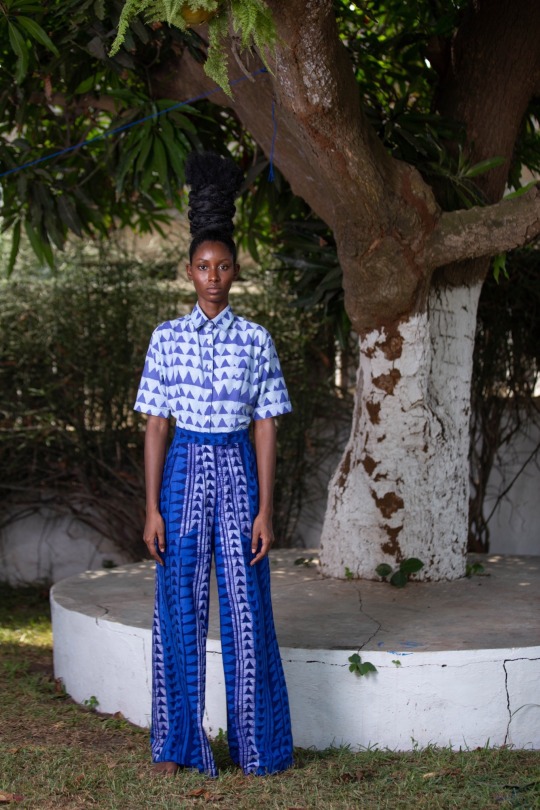
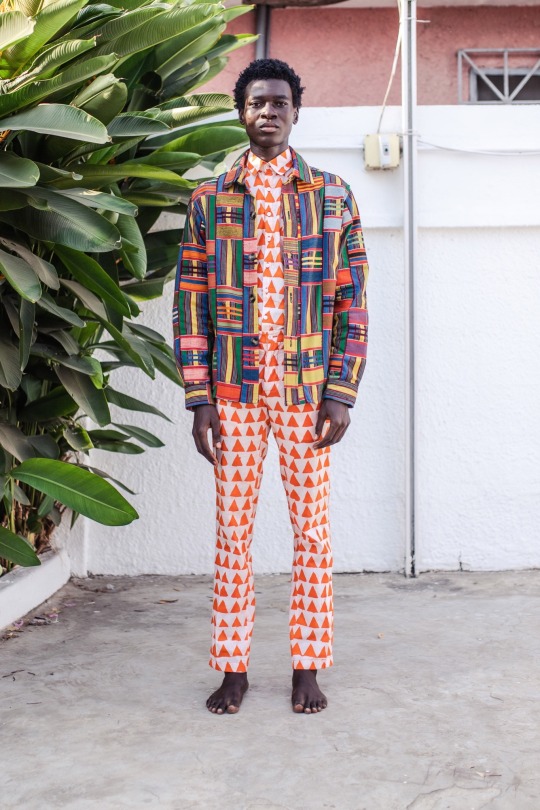
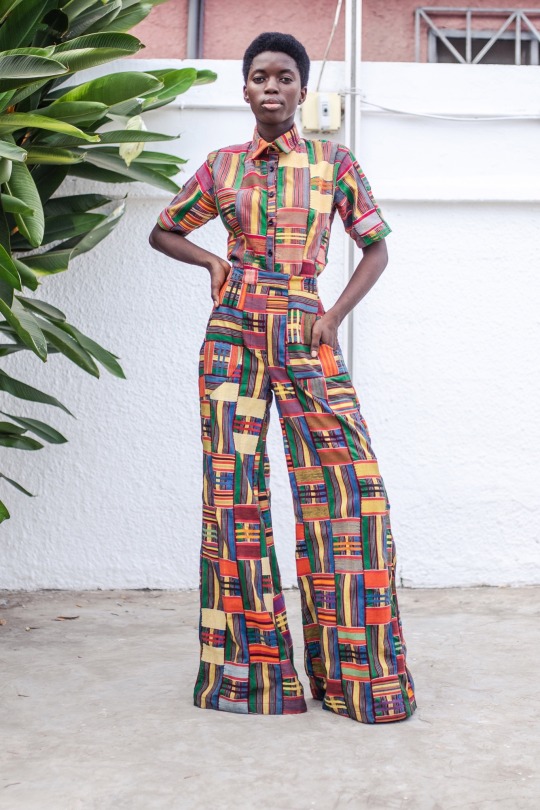
Studio 189 was founded in 2013 by Abrima Erwiah and Rosario Dawson after a trip to Congo. While there they visited the City of Joy, a leadership community for female survivors of sexual violence. This, says Erwiah, “was the beginning of this journey, and it’s about turning pain into power and turning ourselves towards our joy.”
Heritage is the theme explored in the latest collection. One of the ways it is expressed is through the use of Kente, the national cloth of Ghana, that is associated with royalty and has tradition and symbols literally woven into it. This season’s direct references to African clothing and textile traditions make clear that this brand doesn’t cater to Western taste. “It’s about standing in your power,” says Erwiah, who adds that she’s noticed a change among consumers (and buyers), who are becoming less afraid of prints and patterns. These days, she says, people want “more human things, but also more joyful things, more colorful things,” and points to a long skirt with rainbow-colored tiers in the current collection as an example.
One of Studio 189’s missions is to be a bridge between the United States and Africa. On Inauguration day that span extended all the way to the White House: #RosarioDawson and Senator #CoryBooker attended the ceremony wearing matching Studio 189 masks. Laird Borrelli-Persson for Vogue
#studio 189#Abrima Erwiah#Rosario Dawson#fw2021#NYFW#NewYork#Heritage#Kente#Ghana#Fashion#Design and Dialogue#love
128 notes
·
View notes
Text
Shower Power: Revisiting Junya Watanabe’s Rain-Soaked Spring 2000 Collection
BY LAIRD BORRELLI-PERSSON
April 1, 2021
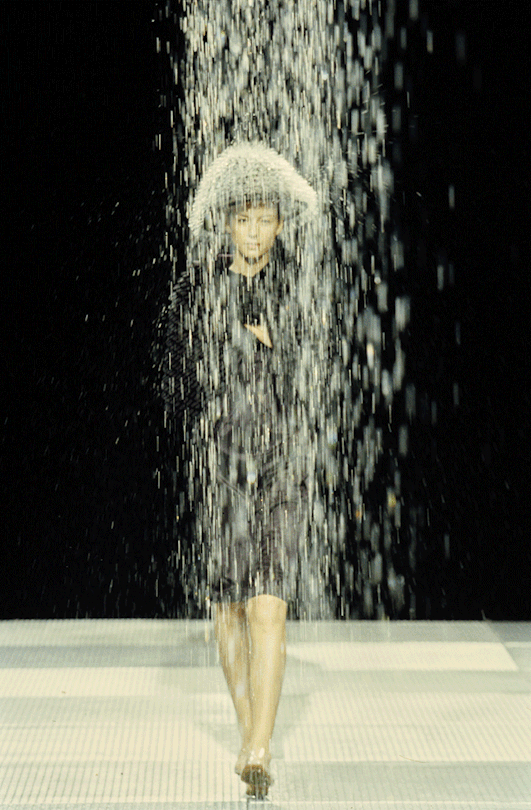
In today’s uncertain climate, many designers are thinking about functionality when creating garments and using technical materials to achieve it. But it was over 20 years ago that the industry started paying attention to these “magic” fabrics that spoke of the future.
Junya Watanabe was one of the designers that pioneered their use. To mimic the effect of the cellophane gel used in lighting, he developed a polyurethane-laminated nylon tricot for his fall 1995 Mutants collection, and his famous, hand-sewn honeycomb ruffs for fall 2000 were made using nylon organza. Manus et machina in action.
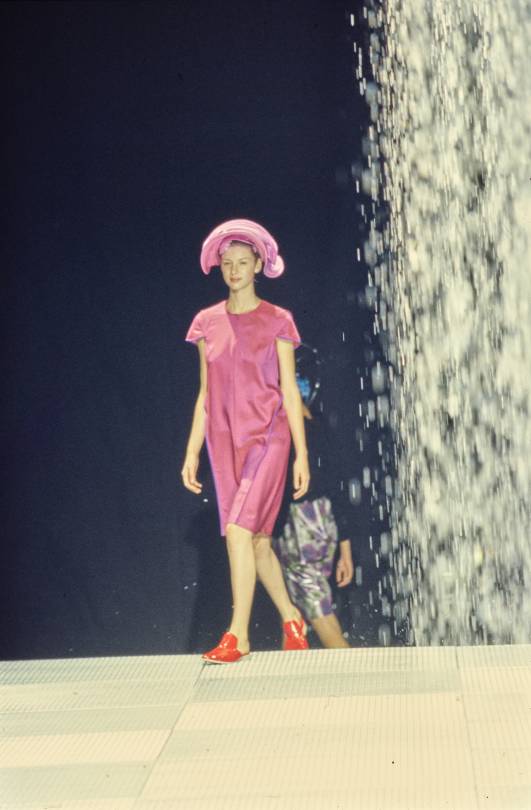
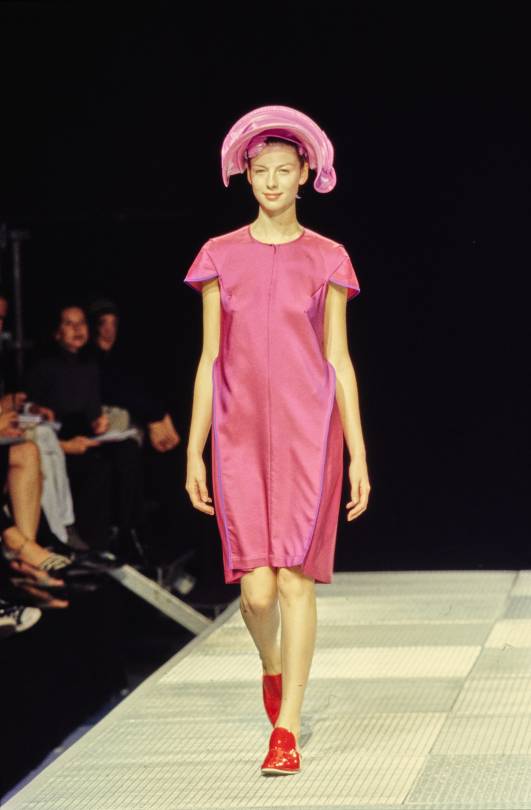
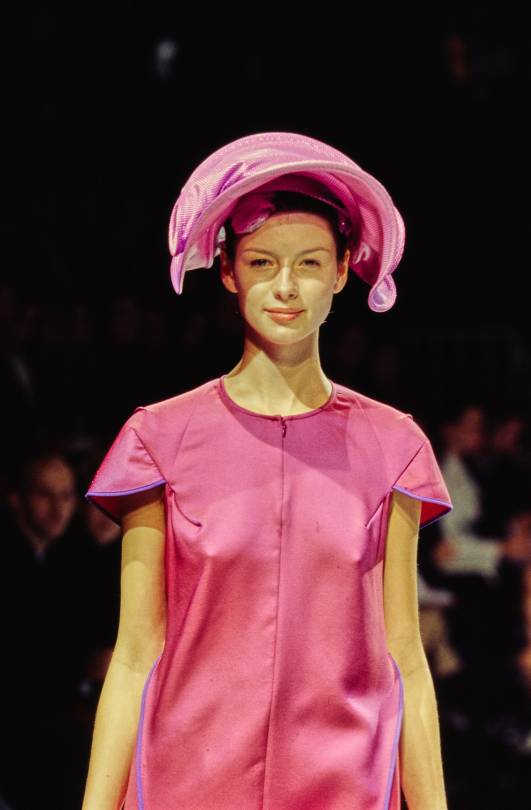
In his spring 2000 collection, titled Function and Practicality, Watanabe made truly dramatic use of a water repellent fabric, created by the Japanese mill Toray. To demonstrate the fabric’s utility, models walked under a cascade of water to the strains of The Carpenters’ 1971 hit “Rainy Days and Mondays.” They wore headscarves and pretty shift dresses in an early 1960s cookie-cutter vein, a number of which were reversible. This was fashion with function, which has long been Watanabe’s way. “Sometimes I feel a little ridiculous putting so much thinking into a dress that looks that simple,” Watanabe told Vogue when talking about an earlier lineup, a sentiment that applies here as well.
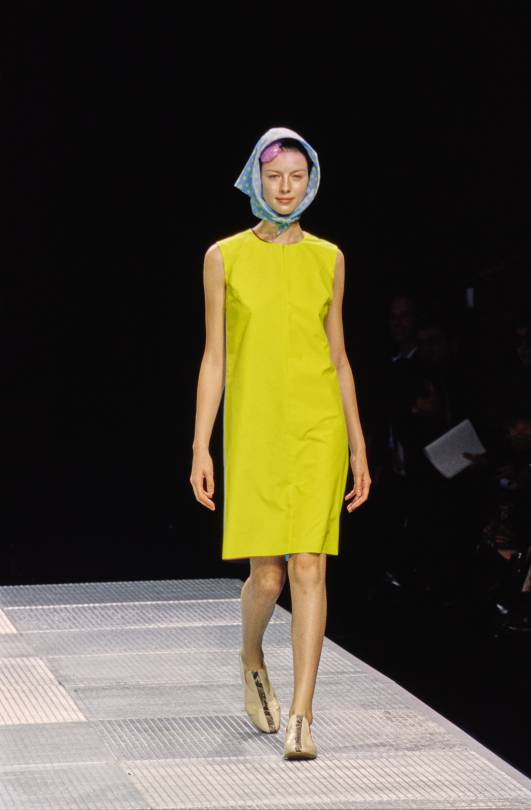
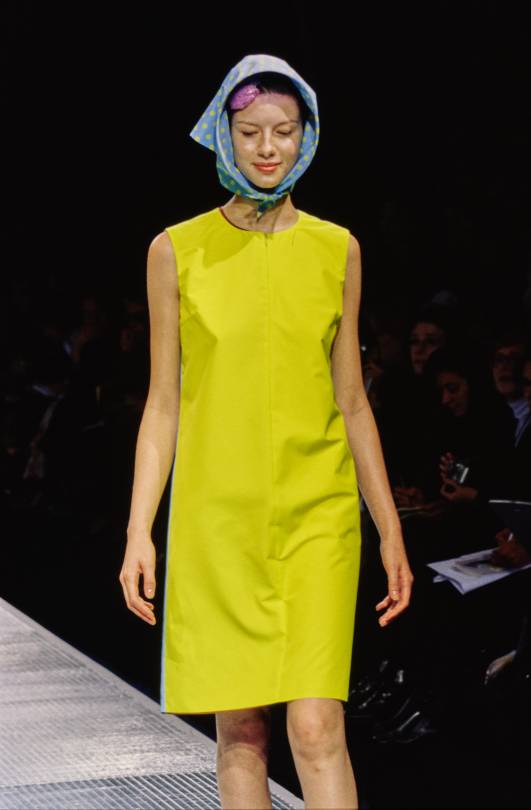
The dresses were colorful and girlish, featuring ruffles and polka dots and florals. “His waterproofs are fanciful, feminine, and metamorphic: a Lilly Pulitzer-esque shift that, if unzipped and unpeeled and rezipped, mutates from one dress to another; a shawl that drops to become the ruffled skirt of a flirty dress,” wrote Sally Singer in Vogue at the time. “Every season, Watanabe takes on an unlikely challenge and overcomes it with humor and a resilient devotion to conservative notions of elegance.”
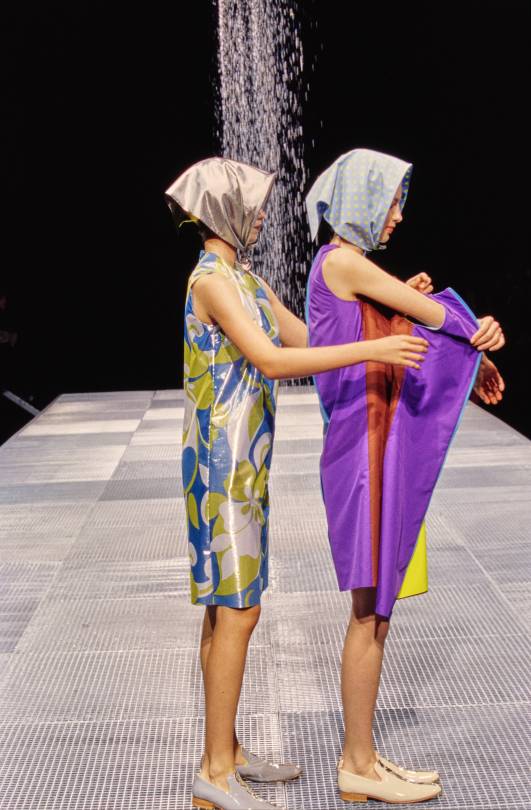
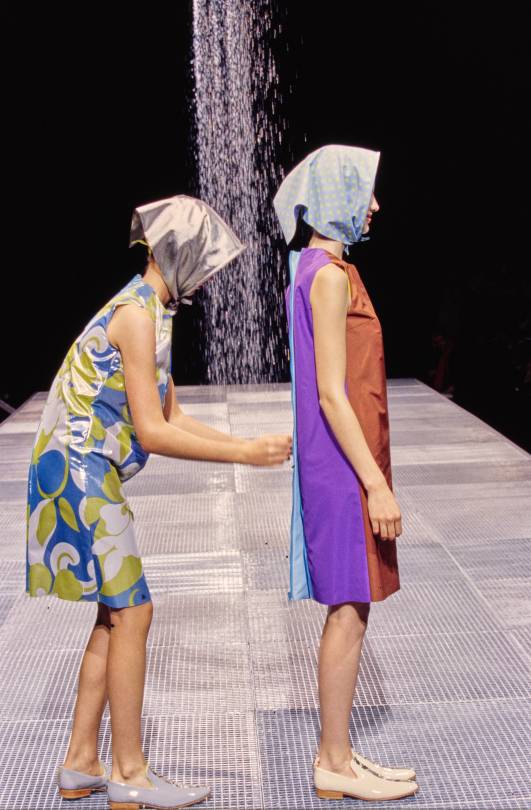
The collection was received with delight, and it’s been reported that the reclusive designer had to take two bows. Outlander star Caitriona Balfe, who opened the show, remembers it clearly. “Walking through the rain effect during the show was magical... you could feel the water drops bounce off the fabric, but other than feeling it on our arms we remained completely dry. There was a palpable buzz coming off the audience and I remember feeling so proud to have been part of something so unique and special.”
Now you can join in the fun as we’ve added newly digitized images of the show to the Vogue Runway archive.
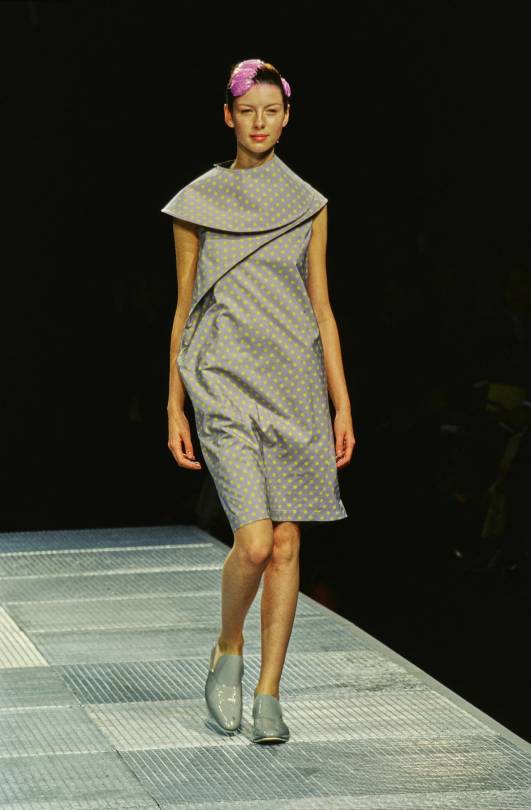

96 notes
·
View notes
Photo

By Malene Birger autumn/winter 2021
LAIRD BORRELLI-PERSSON
“Put a bib on it” seems to be the current Scandi style secret. Maja Dixdotter, the new head of design at By Malene Birger, had layered one over a knit dress when we met on Zoom, and she looked fantastic and warm. It’s squared shape was repeated throughout a confident collection in which comfort was balanced by chic.”
#By Malene Birger#autumn/winter 2021#Maja Dixdotter#Tonal layers#Copenhagen Fashion Week#digital shows#Copenhagen#minimaliststyle#scandi style#Malene Birger#layers#swedish design
36 notes
·
View notes
Link
The magnum opus of his work however is “The Arrow Collar Man”, a character created for a shirt company who became one of the early-20th century’s biggest male sex symbols. “[He] had about as large a place in the pantheon of hotness as Rudolph Valentino, Elvis, and the Marlboro man,” explained Vogue’s Laird Borrelli Persson.
8 notes
·
View notes
Photo

Alexander Fury Explains Why Dior’s New Look Is the Ultimate Example of Escapist Fashion – Laird Borrelli-Persson / Vogue Fashion journalist Alexander Fury on what he learned when working on his forthcoming book, Dior: The Collections, 1947-2017. Source: Alexander Fury on the Making of His New Book, Dior: The Collections, 1947-2017 - Vogue
#Christian Dior#fashion and beauty#fashion and inspiration#Fashion Trends#Laird Borrelli-Persson#The New Look
0 notes
Text
Hiding Homosexuality on the Cover of America’s Magazines a Century Ago
“[Leyendecker] created a counter-image to the Teddy Roosevelt Rough Rider,” explains James Gifford in Dayneford’s Library: American Homosexual Writing, 1900-1913, “appropriating its athleticism but refining it into a male standard with an Americanised version of the Wildean dandy.
One of J.C’s greatest admirer’s was Norman Rockwell, one of America’s most iconic painters. “Rockwell virtually did everything possible to imitate Leyendecker,” says the American Illustrators Gallery, while the latter “received little adulation or credit for his truly iconic images.”

One of the first things you’ll start to notice about Joe Christian Leyendecker’s work is that his women were never quite as good-looking as his men, who were devastatingly handsome. He gave us the elegance of Gatsby 20 years before F. Scott Fitzgerald had even invented him. Take a moment to observe the dashing man on the stairs, who couldn’t be showing less interest in the girl standing below him in the provocative pink slip dress. His gaze is fixed on something, or someone else, and the viewer is invited to guess who that might be. Leyendecker created more than 400 magazine covers during the Golden Age of American Illustration, painting a picture of the new 20th century male and influencing millions of Americans, few of whom knew he was gay. Over a century later, as LGBT advertising is only now just starting to find a place in mainstream media, let’s take a look at the pioneering artist who in retrospect, hardly seemed to be hiding his sexuality at all.


“Actually, it’s pronounced loin-decker”, was likely something Joe uttered a lot. A master depicter of oiled-up hunks, J.C’s ads appeared all across mainstream publications from the early 1900s right up until the Second World War.


The new American male was muscular, often nearly-nude and almost always more interesting to look at than his female counterparts, hiding something in his pre-occupied gaze. Above, Leyendecker’s Gibson girl almost blends into the background as his golfers seem to be in a world of their own. Below, another handsome American male looks distracted as his dance partner appears to be the only one interested in their physical contact.

Joe was born in a German village on the Rhine, and emigrated to Chicago where he studied at the Chicago Art Institute, before going to Paris for a spell. The imprint of the groundbreaking art from those years, from Mucha’s curves to Lautrec’s flushed figures, is something that forever stayed with Joe’s work…


He returned to America in 1899 and hit the ground running, cooking up ads for everything from sock companies to the breakfast food manufacturer, Kellogg’s. He can even be credited with creating the pudgy red-garbed rendition of Santa Claus later adopted by Coca Cola. And most notably, in 1899, he began a 44-yr relationship with The Saturday Evening Post.

The magnum opus of his work however is “The Arrow Collar Man”, a character created for a shirt company who became one of the early-20th century’s biggest male sex symbols. “[He] had about as large a place in the pantheon of hotness as Rudolph Valentino, Elvis, and the Marlboro man,” explained Vogue’s Laird Borrelli Persson.

“The Arrow Collar Man predates Jay Gatsby by 20 years,” Persson notes, “and, critics believe, is referenced when Daisy Buchanan says to Gatsby: ‘You always look so cool. You resemble the advertisement of the man . . . you know, the advertisement of the man.'”
Americans were swooning, as was J.C., and with good reason: the model behind the Arrow Collar Man was none of the than the muse and love of his life, Charles Beach….

Leyendecker lived with Charles in a splendid house in New Rochelle, New York, where they threw party after party in true Roaring Twenties glory, embodying the decadence of the era and indulging in their own real-life Gatsby fairytale thanks to the artist’s success.
If Leyendecker’s sexuality was understood in the industry, it was kept quiet from the audience. But his work did all the talking, albeit in coded messages; suggestive side staring, a preference male-centric environments like locker rooms, clubhouses and tailoring shops. It’s as if Leyendecker was trying to communicate with a gay audience through secret glances and homoerotic undertones. Wartime was also a good space for homoeroticism to hide in plain sight and J. C. painted numerous recruitment posters for the United States military and the war effort.

“[Leyendecker] created a counter-image to the Teddy Roosevelt Rough Rider,” explains James Gifford in Dayneford’s Library: American Homosexual Writing, 1900-1913, “appropriating its athleticism but refining it into a male standard with an Americanised version of the Wildean dandy.
One of J.C’s greatest admirer’s was Norman Rockwell, one of America’s most iconic painters. “Rockwell virtually did everything possible to imitate Leyendecker,” says the American Illustrators Gallery, while the latter “received little adulation or credit for his truly iconic images.”

Collector’s Weekly cleverly points out this side-by-side comparison of their work above.
As time worn on, Leyendecker’s men fell to the wayside of Rockwell’s rosy, small-town USA vision of Americana– which isn’t to discredit Rockwell’s talent or ingenuity, but simply give credit where credit it due. The two did have their differences, after all; just have a gander at the works they made associated with Thanksgiving…

J.C was hit hard by the Wall Street Crash of 1929. By 1943, his editor at The Saturday Evening Post retired, the war was gearing up, and Joe ended up living out the rest of his days with Charles in New Rochelle, welcoming few visitors. Norman Rockwell was a pallbearer at Leyendecker’s funeral. It’s said he told Charles to “destroy everything” upon his death– every love letter, telegram, you name it– that could reveal their relationship. But his true self could never be erased from the loving brushstrokes of every single Arrow Man.


[Source]
84 notes
·
View notes